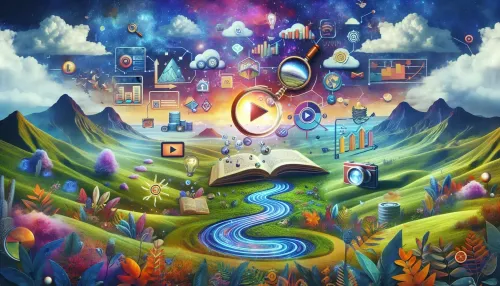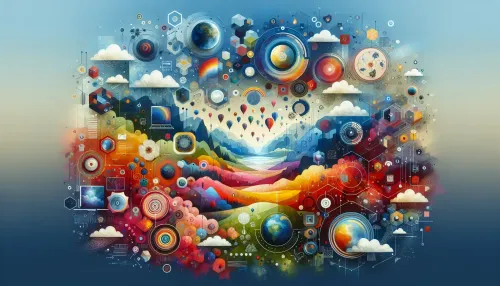The Psychology of Color in Digital Marketing: Impactful Branding and Consumer Perceptions Explored

In the realm of digital marketing, understanding the psychology of color is indispensable for crafting impactful branding strategies and influencing consumer perceptions. The utilization of colors in marketing materials, websites, and advertisements goes beyond mere aesthetics, delving into the realms of triggering emotional responses, guiding purchase decisions, and fostering brand recognition. This article aims to dissect the multifaceted influence of color psychology in digital marketing and explore strategies for leveraging it effectively to maximize brand impact.
The choice of colors in digital marketing materials significantly impacts consumer behavior and purchase decisions. Studies have shown that different colors evoke distinct emotional responses, subsequently influencing consumer perceptions. For instance, red is often associated with urgency and impulse buying, making it a favorable choice for promotions and clearance sales. On the contrary, blue elicits feelings of trust and dependability, often employed by financial institutions and tech companies to establish credibility. Understanding these nuances enables marketers to strategically leverage colors to drive desired consumer actions.
The Influence of Color on Consumer Behavior
Crafting a brand identity that resonates emotionally with the target audience is a pivotal aspect of successful digital marketing. Color psychology plays a vital role in this endeavor, as specific hues can communicate the brand's personality and values effectively. For instance, vibrant and energetic colors like orange and yellow are often used to portray youthfulness and enthusiasm, catering to brands targeting a younger demographic. Conversely, luxurious brands frequently employ deep, rich tones like gold and burgundy to convey sophistication and opulence. By aligning color choices with brand attributes, marketers can strengthen brand identities and foster strong emotional connections with consumers.
How Colors Affect Purchase Decisions
In the era of globalized markets, understanding the cross-cultural implications of color symbolism is imperative for devising effective branding strategies that transcend geographical boundaries. Colors hold diverse meanings across different cultures; while white signifies purity and peace in Western cultures, it symbolizes mourning in many Asian countries. Therefore, multinational brands must conduct thorough research to ensure that their color choices resonate positively across varied cultural contexts. By embracing cultural diversity and adapting color palettes accordingly, brands can cultivate inclusive marketing campaigns that resonate with global audiences.
In the digital landscape, color harmony is paramount for creating visually engaging web designs and marketing collateral that amplify brand messaging. Harmonious color schemes enhance visual appeal and streamline communication by guiding the viewer's focus effectively. Marketers leverage techniques such as complementary colors to create visually striking contrasts or analogous colors for subtle cohesion within designs. By mastering the art of color harmony, brands can elevate their visual storytelling, leaving lasting impressions on their audience.
Related Article: Visual Content Strategy: The Power of Infographics and Video Marketing in Digital Campaigns
Emotional Responses Triggered by Different Colors
The strategic use of color psychology enables marketers to evoke specific emotional responses from consumers, ultimately shaping their perceptions of a brand or product. Warm colors like reds and oranges tend to evoke feelings of excitement and passion, making them suitable for creating a sense of urgency or promoting energy-driven products. Conversely, cool tones such as greens and blues evoke calmness and tranquility, ideal for brands aiming to convey a sense of serenity or eco-friendliness. By aligning color choices with desired emotional responses, marketers can craft campaigns that resonate deeply with their target audience.
Crafting Brand Identities with Color Psychology
In conclusion, the psychology of color in digital marketing is a dynamic facet that wields profound influence on brand perception and consumer behavior. By harnessing the power of color psychology effectively, marketers can elevate brand identities, foster strong emotional connections with consumers, and drive impactful campaigns that transcend cultural boundaries. Understanding the intricate interplay between colors and human emotions empowers brands to craft compelling narratives that resonate deeply with their audience ultimately paving the way for enduring brand success.
Frequently Asked Questions
The impact of color psychology on consumer behavior is significant, as different colors evoke distinct emotional responses. For example, red can create urgency, encouraging impulse buying, while blue fosters trust and reliability. Understanding these effects allows marketers to strategically choose colors that influence purchase decisions and enhance brand perception.
Brands can effectively use color to create emotional connections by aligning their color choices with their identity and target audience. Vibrant colors like orange and yellow convey energy and youthfulness, while deep tones like gold suggest luxury. By selecting colors that resonate with their values, brands can strengthen emotional ties with consumers.
Understanding cross-cultural color symbolism is crucial in marketing because colors have different meanings across cultures. For instance, white symbolizes purity in the West but mourning in many Asian cultures. By researching these differences, brands can ensure their color choices resonate positively with diverse audiences, enhancing global marketing effectiveness.
Check Out These Related Articles

Content Marketing Unleashed: Crafting Compelling Narratives to Drive Engagement

The Art of Digital Storytelling: Engaging Audiences through Narrative Mastery

Creating Compelling Visual Content: Design Hacks for Eye-Catching Digital Campaigns

